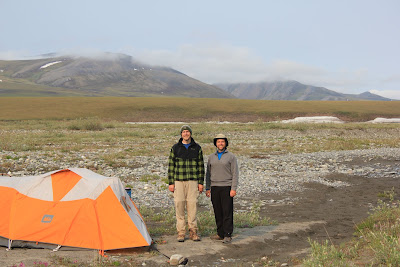We stayed three days at Caribou Pass before getting picked up. The river droned constantly among the foothills of the northern Brooks Mountains. Of course, these "foothills" are much higher than most places I am accustomed to in Illinois. Migrating Caribou and other animals take advantage of gaps in the landscape to make thier joureny easier. Caribou Pass is a place where herds of caribou "pass through" the mountains on their way to or from the coastal plain where they give birth to their young.
 |
| Caribou |
Most of the movement had already taken place when we were at Caribou Pass, though we did see 2 lone Caribou. One of them trotted right next to our camp. It was very curious about us. It would pace back and forth and then stare at us for a bit, then pace some more. It was traveling south.
 |
| Caribou |
Another one came through while we were coming back from our hike in the foothills. I tried to get closer, but it was traveling north and crossed the river (too deep for me to wade through). It behaved similarly as the other one, trotting a little, then looking back at me, never really running away. This one had much more developed antlers. I don't know the sex of either one, since both male and female Caribou grow antlers. I suspect they were lone males, since there were no calves. Several days earlier we saw a mother and calf walk along the river on top of some
aufeis.
 |
| Arcic Ground Squirrel |
I really enjoyed the time at Caribou Pass. We also saw a Moose in the hills across the river from us. Although we saw Bald Eagles and Golden Eagles every day in the Arctic Refuge, one day at Caribou Pass, a Bald Eagle directly passed overhead. A colony of Arctic Ground Squirrels were active in and out of their borrows near our camp, always more easily heard than seen.
 |
| Juvenile Baird's Sandpiper |
At Caribou Pass we encountered a number of juvenile Baird's Sandpipers and Semi-palmated Plovers. Shorebird parents stick around long enough for the chicks to hatch and assist with basic feeding, but they migrate south before the young fully fledge. The juveniles migrate south on their own later in the summer. The miracle is that they "know" in their genes where to go and when: they would never survive an arctic winter. I was really excited to see a trio of Parasitic Jaegers hunting the riverbed for young sandpipers and plovers. The jaegers are sort of like a cross between a raptor and a gull.
 |
| Juvenile Parasitic Jaeger |
On the day of departure, we confrimed our new pick up location, packed up our gear, and waited for the plane. The weather was kind of drizzly and then turned to rain. We had packed the tent, in order to be ready when the plane arrived. We didn't want to make the pilot have to wait on us for not being prepared. But after 4 hours of standing in a cold downpour waiting for the pilot to come, we have questioned the wisdom of our being so courteous. Thank God for the Hely Hansen raingear!
Our self-guided expedition into the Arctic National Wildlife Refuge tested our skills, endurance, and adaptability. We didn't get as far as we planned, but we experienced a place that is wild and beautiful [and protected] on a landscape scale. We will probably never return to the Kongakut, since there is so much more to see, but I will always cherish the memories of those 11 days of arctic wilderness.






No comments:
Post a Comment